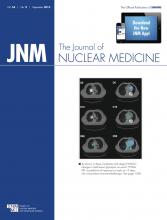Cancer surveillance imaging: Weber and Wahl offer perspective on the multiple factors and challenges affecting surveillance imaging in patients with cancer, with a focus on existing evidence supporting its utility and the framework needed for additional studies.
Reassessing PET/CT cancer surveillance: Eary and Krohn provide a critical review of findings in an article in this issue of JNM on PET and PET/CT surveillance in patients with treated cancers.
Evidence for imaging surveillance: Patel and colleagues report on the results of a systematic review of studies on the diagnostic accuracy and clinical impact of PET and PET/CT used for surveillance in several cancers.
PET and response in NSCLC: Usmanij and colleagues evaluate the potential of 18F-FDG PET changes for prediction of response to concomitant chemoradiotherapy in patients with locally advanced non–small cell lung cancer.
Combined radioisotope therapy in NHL: Hobbs and colleagues describe a combined methodology for myeloablative treatment of non-Hodgkin lymphoma using 131I-tositumomab and 90Y-ibritumomab tiuxetan.
FMISO and FLT in lung cancer: Thureau and colleagues compare scoring of tracer uptake intensity, definition of hypoxic and proliferative volumes, and segmentation methods across 18 centers participating in a study of non–small cell lung cancer.
18F-ICMT-11 dosimetry in humans: Challapalli and colleagues detail in healthy human volunteers the safety, biodistribution, and internal radiation dosimetry profiles of this caspase-3–specific PET tracer for apoptosis imaging.
Alternative to 90Y PET?: Elschot and colleagues introduce and validate a new reconstruction method for quantitative 90Y bremsstrahlung SPECT to improve dosimetry after radioembolization of liver malignancies.
PET time correlation coefficient in AD: Shokouhi and colleagues report on longitudinal changes in brain glucose metabolism and their relationship to cognitive status in Alzheimer disease to determine correlations in 18F-FDG spatial distribution over time.
Repeat 11C-PiB amyloid imaging: van Berckel and colleagues identify optimal quantitative and analytic methods for measuring longitudinal changes in 11C-Pittsburgh compound-B binding in patients with progressive cognitive impairment.
PET and cervical myelopathy: Floeth and colleagues use 18F-FDG PET to prospectively assess regional changes in glucose metabolism in the cervical spinal cord in patients with degenerative spinal stenosis and symptomatic cervical myelopathy after decompressive surgery.
MR and fMRI for BAT: Chen and colleagues describe MR and functional MR applications to assess the volume and function of human brown adipose tissue and responses to mildly cold stimulation in cervical areas in human volunteers.
V/Q SPECT and SPECT/CT: Roach and colleagues provide an educational overview of the advantages of planar ventilation–perfusion SPECT and it applications, with or without CT, in pulmonary conditions.
α-RIT for multiple myeloma: Chérel and colleagues explore 213Bi-labeled anti-mCD138 radioimmunotherapy efficacy in multiple myeloma minimal residual disease treatment in mice with low tumor burden.
Hypoxia-enhanced bombesin conjugates: Zhou and colleagues describe investigations of the in vivo properties of hypoxia-enhanced, 111In-labeled gastrin-releasing peptide receptor–targeted agents in a human prostate cancer xenograft mouse model.
Melanoma response to σ ligand: Rybczynska and colleagues determine whether the σ ligand rimcazole inhibits growth of A375 M melanoma xenografts in nude mice and whether rimcazole treatment changes 18F-FDG uptake in vivo.
p53 in 64Cu-cetuximab RIT: Guo and colleagues examine in mice the role of tumor suppressor protein p53 in response to 64Cu-DOTA-cetuximab treatment, with and without cisplatin, and describe the potential for personalized clinical strategies in colorectal cancer.
PET and therapy response in tumors: Goggi and colleagues evaluate the utility of various PET imaging biomarkers for early determination of response to therapy with the antiangiogenic agent axitinib in tumors with diverse biologic characteristics.
rMGU quantification in mice: Thorn and colleagues detail a noninvasive and repeatable method for assessing mouse myocardial glucose uptake with 18F-FDG PET and Patlak kinetic analysis using the vena cava image–derived blood input function.
Quantification of cardiac nerve density: Raffel and colleagues determine whether analyses of 11C-GMO kinetics can provide robust and sensitive measures of regional cardiac sympathetic nerve densities.
PET for PBF: Pouzot and colleagues report on the use of regional fraction of blood to assess pulmonary blood flow with 18F-FDG PET and compartmental modeling of 15O-H2O kinetics as a reference method in animals with acute lung injury.
Macrophage polarization and glucose uptake: Tavakoli and colleagues describe detection of enhanced glucose uptake with 18F-FDG PET as a noninvasive approach to explore the effect of macrophage polarization on glucose metabolism and oxidative phosphorylation.
In vivo selectivity of κ antagonist: Kim and colleagues investigate the in vivo selectivity of 11C-LY2795050, a novel κ-selective antagonist PET tracer, in monkeys.
MITA on PET research: Hillman and colleagues provide the results of a 2012 Medical Imaging & Technology Alliance meeting addressing clinical research endpoints that may be appropriate as evidentiary standards in supporting Medicare coverage of new PET radiopharmaceuticals and procedures.
- © 2013 by the Society of Nuclear Medicine and Molecular Imaging, Inc.







